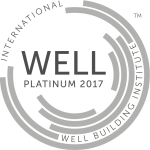Workplaces that enhance employee health and well-being also enhance productivity — and employers’ financial bottom lines. Companies throughout the country are handing out fitness trackers, stocking their workplaces with nap pods and providing stipends for employees to relocate near the office, reducing their carbon footprint as
well as their commute time. In other words, these companies are overwhelmingly demonstrating how much they value wellness in the workplace, by directly investing in programs to support employee well- being. But there’s another approach, one that unilaterally improves the productivity and happiness of all employees: designing and building for wellness.

WELL
The International WELL Building Institute (IWBI) is leading the global movement to transform our buildings and communities in ways that help people thrive. IWBI delivers the cutting-edge WELL Building Standard, the first to be focused exclusively on the ways that buildings, and everything in them, can improve our comfort, drive better choices, and generally enhance, not compromise, our health and wellness.
Its work extends to advancing health through design for entire neighborhoods through the WELL Community Standard Pilot and convening and mobilizing the wellness community through management of the WELL AP credential. Launched in October 2014 after six years of research and development, the WELL Building Standard is the premier standard for buildings, interior spaces and communities seeking to implement, validate and measure features that support and advance human health and wellness.

FITWEL
FITWEL is cost effective, high impact, health promoting building certification.
FITWEL Certification articulates a vision for the future where every building is enhanced to support the wellbeing of its occupants, and surrounding communities. It is a new and emergent building certification that positively impacts occupant health and productivity through workplace design and operations. FITWEL’s development was led by the U.S. Centers for Disease Control and Prevention and the General Services Administration. The scale of potential impact cannot be overstated. There are more than 5.6 million commercial buildings in the U.S., with 120 million employees who spend an average of 8.1 hours at work each day.
By applying incremental changes over time, these buildings can be optimized to promote occupant health. FITWEL has a goal of impacting individual health within all buildings, regardless of budget, size, year built, or location.
For a comparison of the two certifications, check out this article from Kelsey Alexander, a Sustainability Consultant at Sustainable Investment Group (SIG). https://www.sigearth.com/fitwel-vs-well/


